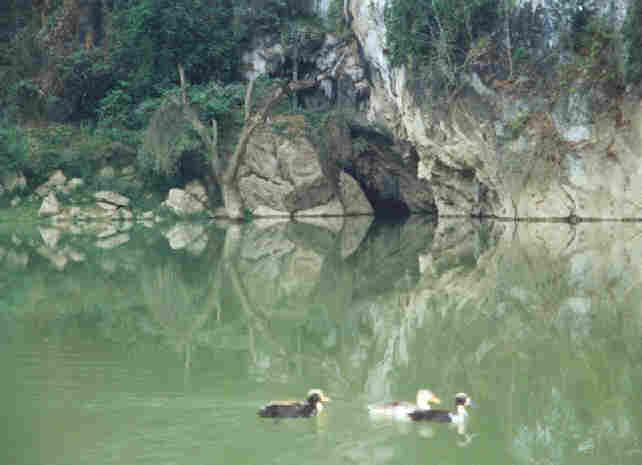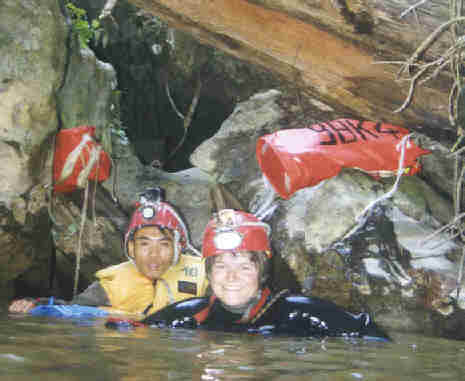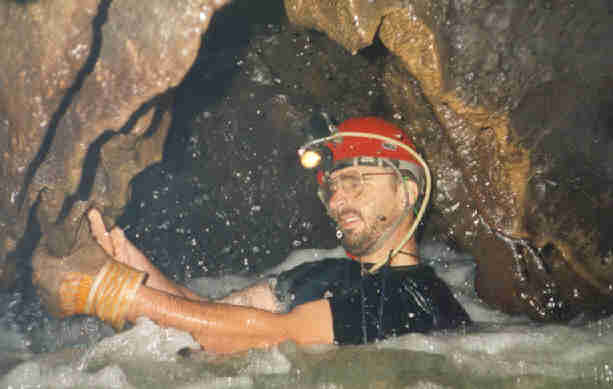 However, during a reckon trip in 1995, the cave was
already visited and the river was followed some hundreds of
meters without caving gear and diving suit. This entrance
should be visited again, when no lake is present.
However, during a reckon trip in 1995, the cave was
already visited and the river was followed some hundreds of
meters without caving gear and diving suit. This entrance
should be visited again, when no lake is present. AREA 11: Chieng Ban
CB1 Chieng Ban 1
Some kilometres before the Chieng Ban river reaches the Nam Mu
river, the former disappears underground twice. First, the river
disappears in a large porch that can be seen from Route No 6. The
entrance is very big and beautiful to look at. The day before
exploration, we had some rain during the night. The underground
Chieng Ban could not drain all of that water and a big lake was
created before the first entrance (see picture). At that time the
underground river could not be followed very far.  However, during a reckon trip in 1995, the cave was
already visited and the river was followed some hundreds of
meters without caving gear and diving suit. This entrance
should be visited again, when no lake is present.
However, during a reckon trip in 1995, the cave was
already visited and the river was followed some hundreds of
meters without caving gear and diving suit. This entrance
should be visited again, when no lake is present.
CB2 Chieng Ban 2
The resurgence of the underground river can be found on the
other side of the hill, by following the river upstream, where
beautiful mayflies hang around. Just before the entrance one
climbs over large rocks and a fallen tree. The porch is quite
narrow and high and gives into a water filled gallery where
swimming is pleasant, once interrupted by a dry passage. On the
right side a boulder slope can be climbed, which leads to another
entrance higher up the hill which is less easy to access. On the
right side the shallow water is followed  through
a wide passage in which the ceiling lowers. In a remarkable turn
to the right, flowstone and gour pools can be found, formed by a
small inlet coming out of a tiny sump. Above it, there is a large
and almost perfectly rounded hole (1m in diameter). The gallery,
with white veins in the dark limestone gets narrower and the
water flow faster. Here a labyrinthic network of small passages
can be accesses behind red flowstone (not surveyed). After a turn
to the left, the way on is divided in two by a large and long
rock; the water flows on the right side, the left side is wider
and dry, the bottom is covered with rounded pebbles in large,
worn out solution pockets. Then one has to climb up to the fossil
part, on top of blocks, as high as average Vietnamese houses. It's
hard to estimate the dimensions of this huge chamber. The high
ceiling may indicate that a doline is being formed and another
karstic window will open. A hanging keystone between two blocks
leads to the water again which is followed along the eastern wall.
A large flowstone formation is seen, on top of which strange
‘bell-like' formations were found. On the left side there's
a fossil passage through the flowstone. Behind this, the water is
reached again by walking over logs. A narrow canyon in which the
water flows very fast is followed. The ceiling, in which a
parallel fossil passage can be distinguished, lowers. The way on
is divided over about 15m and becomes more rectangular. Here the
bottom consists out of a series of basins. The ceiling lowers
again, where rapids precede the cascade of 2m, which was hard to
climb because of the high discharge that day and the turbulence
beneath it. On top of it, a slippery part leads to a small
natural dam. About 40m further on, we arrived in the final 'room'
in which two showers sprayed water down. This point is underneath
the Chieng Ban lake... and the choke in the roof was nice and
strong enough to hold while we were surveying out way back out.
through
a wide passage in which the ceiling lowers. In a remarkable turn
to the right, flowstone and gour pools can be found, formed by a
small inlet coming out of a tiny sump. Above it, there is a large
and almost perfectly rounded hole (1m in diameter). The gallery,
with white veins in the dark limestone gets narrower and the
water flow faster. Here a labyrinthic network of small passages
can be accesses behind red flowstone (not surveyed). After a turn
to the left, the way on is divided in two by a large and long
rock; the water flows on the right side, the left side is wider
and dry, the bottom is covered with rounded pebbles in large,
worn out solution pockets. Then one has to climb up to the fossil
part, on top of blocks, as high as average Vietnamese houses. It's
hard to estimate the dimensions of this huge chamber. The high
ceiling may indicate that a doline is being formed and another
karstic window will open. A hanging keystone between two blocks
leads to the water again which is followed along the eastern wall.
A large flowstone formation is seen, on top of which strange
‘bell-like' formations were found. On the left side there's
a fossil passage through the flowstone. Behind this, the water is
reached again by walking over logs. A narrow canyon in which the
water flows very fast is followed. The ceiling, in which a
parallel fossil passage can be distinguished, lowers. The way on
is divided over about 15m and becomes more rectangular. Here the
bottom consists out of a series of basins. The ceiling lowers
again, where rapids precede the cascade of 2m, which was hard to
climb because of the high discharge that day and the turbulence
beneath it. On top of it, a slippery part leads to a small
natural dam. About 40m further on, we arrived in the final 'room'
in which two showers sprayed water down. This point is underneath
the Chieng Ban lake... and the choke in the roof was nice and
strong enough to hold while we were surveying out way back out.
CB3 Chieng Ban 3
Following the surface Chieng Ban river from CB2 further trough the valley for some 400m to the north, another vanishing point of the river is found. The underground river follows some big bends, with chambers on both sides of the river. The high chamber on the left side can be climbed on flowstone that gives into another chamber full of bats. The river stops rather quickly after some 200m on a sump. This sump looks just like the final sump of CB4, and it has exactly the same direction. Both sumps are probably close to each other.
CB4 Chieng Ban 4
The second resurgence of the Chieng Ban river is easy to find: it can be seen from Route No 6, just before the village of Cau Huoi Long, when coming from Tuan Giao. The river resurges out of the hill, flows under the bridge of Route No 6 to reach the confluence with the Nam Mu river.
Following the Chieng Ban river upstream towards the resurgence,
we climbed upon a small dam, made by the locals to tap water in
the cave in a small underground lake. From here you can see the
second entrance, higher on the slope. In a wetsuit, it’s a
pleasant swim to the other side of the lake, where the  underground river can be followed through a wide
gallery. The riverbed only covers part a small of the gallery.
From here, there are two ways on: leaving the river and follow
the dry gallery, or continuing in the river. Following the dry
gallery, it’s an easy walk through the cave. The cave goes
gently upward, up to a boulder slope. Later on, we explored the
surroundings outside and found a doline just above the boulder
slope. In this gallery, small cave pearls can be found. At
the time the cave was explored, the water was high, and some
ducks (duck1 and 2) had to be taken when following the other way
on, swimming in the river. After a short distance, the river
crosses the gallery, where a nice beach is a good pick-nick site.
By diving under a flow stone, (duck 3), we reached an active
gallery, not wider than the river, where the water is several
meters deep. A long and more active gallery follows, with first
another duck (duck 4) and then rapids, where the river is shallow
and progression was faster. A first sump can be bypassed by a
climb on the right side. One needs a small rope to go back down
to the river.
underground river can be followed through a wide
gallery. The riverbed only covers part a small of the gallery.
From here, there are two ways on: leaving the river and follow
the dry gallery, or continuing in the river. Following the dry
gallery, it’s an easy walk through the cave. The cave goes
gently upward, up to a boulder slope. Later on, we explored the
surroundings outside and found a doline just above the boulder
slope. In this gallery, small cave pearls can be found. At
the time the cave was explored, the water was high, and some
ducks (duck1 and 2) had to be taken when following the other way
on, swimming in the river. After a short distance, the river
crosses the gallery, where a nice beach is a good pick-nick site.
By diving under a flow stone, (duck 3), we reached an active
gallery, not wider than the river, where the water is several
meters deep. A long and more active gallery follows, with first
another duck (duck 4) and then rapids, where the river is shallow
and progression was faster. A first sump can be bypassed by a
climb on the right side. One needs a small rope to go back down
to the river.
The next day, the water wasn’t that high anymore, making duck 3 easy to pass. In the active gallery, fish were seen. After anchoring a small rope above a small pitch, we reached the other side of the sump behind the bypass. About 50m further, a second sump could easily be bypassed on the right side. From there, the gallery gets larger, with dimensions resembling the end of CB3. The final sump also looks very similar to the one at CB3.
The four caves described above make up the complete system of the underground Chieng Ban river.